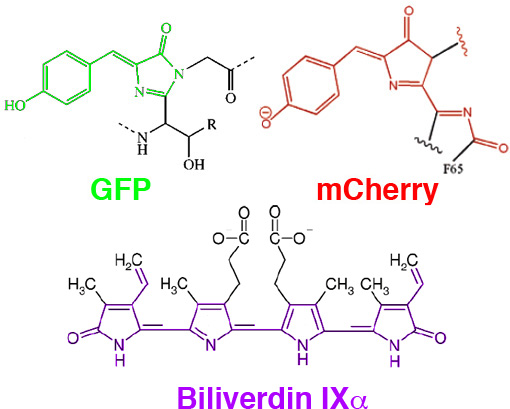Takeharu Nagai’s lab has published in Nature Methods, Spontaneous network activity visualized by ultrasensitive Ca2+ indicators, yellow Cameleon-Nano, demonstrating a new set of calcium indicators based on yellow cameleon. Back when he was still Take-san, Take’s ability to churn out and manually screen hundreds of cameleon variants was impressive and inspiring. With high-throughput GECI pipelines now ramping up at Janelia, the idea of laboriously screening 200 variations on a theme (be it cameleons or GluSnFRs), seems a bit archaic. However, this paper is a good example of the progress that can still be made by understanding the needed sensor parameters and fiddling with the primary amino acid structure in a relatively low-throughput way. Take-sensei’s results are another example of the pramatic rule in protein design, “when in doubt, tinker with the linker.”
The cameleon-nano family achieves greater apparent calcium affinity than YC2.60-4.60, reaching levels of up to 15nM. They did this by increasing the flexibility of the linker by extending the standard Tsien/Miyawaki/Baird Gly-Gly-Ser linker with additional glycines. In this case, the longer the linker between the CaM and M13 segments, the greater the apparent affinity. Interestingly, improvement by increasing linker flexibility is precisely the opposite the advice Atsushi and Take gave me for achieving high ratio changes with FRET reporters. Back at RIKEN in 2002, they suggested I use short, stiff linkers to restrict the rotational freedom of the fluorescent pairs. Then one could find orientations where relative rotation of dipole moment gave much greater FRET changes than would be expected from changes in FP distance alone. Take and Atsushi’s big YC2.60/3.60 paper strongly supported this idea! However, as our understanding of the ideal parameters of calcium sensor’s for in vivo imaging has grown, development directions have adjusted.
Cameleon-Nanos achieve higher signal/noise for sparse action potentials at the expense of linearity. Like Fluo-4, the signal saturates at relatively low AP frequencies. I think the absolute affinities measured for this family (15, 30, 50 and 140nM) should be considered very rough estimates. They extrapolated these values from stopped-flow binding experiments, because
Although we would like to measure the koff of YC2.60 and its high affinity variants such as YC-Nano15, we could not do it because it was very difficult to precisely control free Ca2+ concentration at around few tens of nM as far as we used EGTA (Kd for Ca2+ = 151 nM in 0.1 M ionic strength, pH 7.2 at 25 oC). For this purpose, much stronger Ca2+ chelator with a smaller Kd value was required. However there is no such Ca2+ chelator available now.
I’m not sure why they didn’t just use the higher affinity, Mg++ insensitive, chelator BAPTA to make the Kd measurements the right way, with a linear regression of log-log fluorescence/concentration values. Due to instrument dead time, and the high affinity, I didn’t like stopped-flow based Kd measurements in the early GCaMP papers, and I don’t like them now. Also, the apparent calcium Kd will be highly dependent on solution ionic strength and [Mg++] which is unreported. Despite these quibbles, which are important only inasmuch as they give insight into the mechanism of improvement and the direction of future development, the cameleon-nano family looks promising for mammalian brain imaging. I still wonder if, assuming the reported Kd values are relevant in vivo, YC2.60 would be the best of the bunch, since cortical neurons have a resting Kd of ~50nM, which implies that a single AP transient of say 200nM free [Ca++] increase would push the calcium levels right up into the sweet-spot of YC2.60’s sensitivity.
This is all the more interesting given the recent results in YC3.60 imaging from Maz Hasan’s group. Previously, he had shown that transgenic YC animals were pretty bad for imaging. However, AAV-mediated gene delivery of YC3.60 has significantly improved the responses of the YC family. I’m not sure if they are really up to GCaMP3 levels under identical in vivo conditions, but they might have better long-term protein stability (or that might depend on which viral serotype is used.) What about cameleon-nanos, what about YC2.60?





![[beta]](https://i0.wp.com/scripts.iucr.org/logos/entities/beta_rmgif.gif) = 100.5° and one GCaMP2 molecule in the asymmetric unit. The structure was phased by molecular replacement and refinement is currently under way.
= 100.5° and one GCaMP2 molecule in the asymmetric unit. The structure was phased by molecular replacement and refinement is currently under way.
 Bo Shui
Bo Shui





Recent Comments